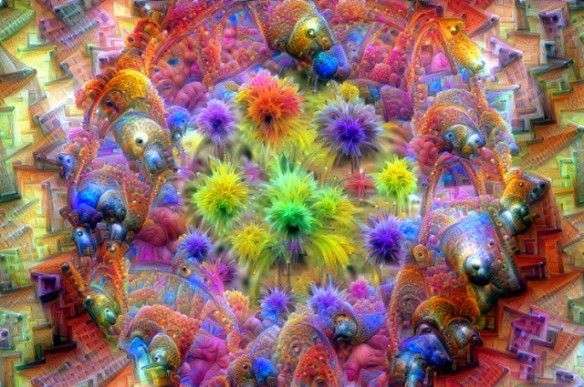When we came up with the idea to restart the 3-1 series with a collection of posts on “the future of …[FILL IN THE BLANKS]”, my initial thought was to end this collection – much later this year – with a post on “the future of … futures”. I told Nicholas about that and his answer his reaction was as hilarious as fitting: While a last post on that would be the obvious and reflexive thing to do, opening up with it would be even better as it sets the stage for whatever will follow. So here I am, time is up, “2 minutes left and 10 slides to go”: The future of … futures!
The future is newer just what follows today. It always carries a time stamp, an indication of source and a lot of birthmarks linking it back to the practices, processes and the machinery of its production. A future is always someones future, in a specific time, at a specific location, created with words, imagination and, most importantly, with methods. These futures (present, past or future futures) are fabricated, made, maintained, they are backed-up, contested and used – for planning, dreams and fear. The means, tools and methods we use to make up these futures, let them circulate and turn them into effective devices change: we used to make up futures by prophecy and by myths, we asked gods and oracles as well as strangers that looked well traveled and wise, we created utopias and dystopias as guiding narratives and looked for their manifestations.
A very classic modern way of making up (and multiplying) futures are scenarios and the tools, workshops and projects in which they are created. I am pretty sure that scenarios will pop up in one of the next posts as I happen to know a few scholars that are very interested in them. A closer look into the laboratories of data science and the workshop of machine learning engineers reveals a very contemporary urge for new forms of prediction and of methods and algorithms that turn past patterns (in data) into more or less confident guesses of what will follow. Do you like these books? You might want to look at this messenger bag! How about more “Last Christmas?”? We noticed you seemed to like that a lot last month! Where should we send security and police officers to prevent crime? To areas that were previously high risk areas.

CC: Gene Kogan@Flickr (CC BY-SA 2.0)
https://www.flickr.com/photos/genekogan/35074133424/
I do not want to open up questions of bias, transparency or fairness, as there is an ever growing STS and critical data/algorithm studies that does such a good job regarding these issues. I am, for the purpose of this 3-1 restart, more interested in this: With all those means, tools and methods in mind – how does the future of futures look like? These futures are unstable, but effective. They can change after the next recalculation, but they are also very performative by narrowing down the corridor of choice. They rely on the past, but do not necessarily reproduce it. They depend on the tools of future-making that we create today.

Pingback: 3:1 — Future of Futuring — Post 3 of 3 | Installing (Social) Order
Pingback: 3:1 — The Future of the Future — Post 2 of 3 | Installing (Social) Order
just suspicious about how much we can say (with any teeth in terms of being about anything actual and not just applying physics) about something as broad ‘the future’ as opposed to talking about the future of something in particular and since we are talking about human-doings than about specific tasks/assemblages. The old problem of environmental awareness (things being/happening in contexts which make a difference, and in/of contexts that are changing, etc) is how to decide what factors make a difference that must be accounted for (attended to), how far does one have to trace out (or in) all the associated factors and I think that can’t be answered apart from the interests at play in those asking the question, what matters to them if you will. There have been all kinds of attempts to turn what is the case into what ought to be case in ways that somehow transcend this basic politics of the people inquiring/implementing by waxing theological, philosophical, or more recently by way of calculations but none of them actually transcend the people involved.
just got this to add to the reading list:
https://www.academia.edu/37065594/Infrastructures_of_liberal_life_From_modernity_and_progress_to_resilience_and_ruins
LikeLike
Aren’t we always making the future? That’s a great question, fore, if the answer is at all close to yes, then we are in trouble because if we are always “future-making” then it is nothing special at all. Is that, though, a problem? What problems emerge if we don’t reallyregard “doing stuff” as “future-making?”
LikeLike
sure but futures of what tho I think is key, otherwise how does one even begin to know what factors might be in play? Don’t these sorts of mechanisms gain much of their meaning in use (not unlike language) and so we need some specifics, do they have general affordances and resistances?
https://en.wikipedia.org/wiki/Affordance
LikeLike
Indeed and agreed – although I was trying to focus on other forms of “something concrete”. There is a changing repertoire of practices, tools and methods through which contemporary societies produce futures: like predictive systems and data driven simulations for example. And I was wondering how _their_ future might look like…
LikeLike
isn’t everything we do (and more broadly everything that happens) making the future? I would think perhaps we might focus on something more narrow/concrete, something more like specific projects, how we decide what to do (with what and whom, etc) and how we know what we are doing as we go along, what the impacts are, how can we be more reflexive, etc?
LikeLiked by 2 people